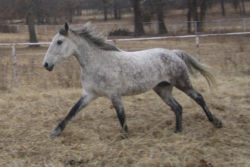Bashkir Curly
American Bashkir Curlies or North American Curly Horses)
Sat, 16th November, 2024 - 8:34 am GMT
Sponsor Ads:

Alternative Name
American Bashkir Curlies or North American Curly Horses)Basic Info
Bashkir Curly is a breed of horse. Bashkir Curlies (also called American Bashkir Curlies or North American Curly Horses) come in all sizes, colors, and body types but all carry a gene for a unique curly coat of fur. This gene can be expressed minimally (horse exhibits curly hair inside ears, at fetlocks, and a kinky mane and tail), maximally (horse exhibits curl all over body, has no mane or extremely dreadlocked mane, and has curly eyelashes and guard hairs), or any variation in between. Because the trait can be carried heterozygously, some purebred Bashkir Curlies exhibit no curl at all! Bashkir Curly in full winter coat.Bashkir Curlies are most commonly chestnut colored, but can be found in every color from standard bays, blacks, and greys, to appaloosa markings; from pinto patterns to dilute colors such as buckskin, grulla, and cremello. Most curlies stand between 14 and 15 hands, though curlies can range from 11 hands up to over 16 hands.
Health
Bashkir Curlies are the only hypoallergenic horse breed; Most people allergic to horses can handle curly horses without suffering any allergic reaction. Research indicates a protein is missing from the fur of Bashkir Curlies which may be what causes allergic reactions to horses in allergy suffers. There have been reports of allergic reactions to curly horses, but it is suspected those reactions are to secondary allergens such as hay in the area, dust in the fur, or cross contamination from pasture-mates of other breeds.Habitat
N/ABehavior
Though eye catching and unusual in the show ring, Bashkir Curlies have the movement, endurance, and heart to excel in competition. Several Bashkir Curlies have made a name for themselves at upper levels of dressage and show jumping, but countless others have proved the reliable mount and patient teacher for the weekend competitor. Curlies are characteristically quiet, level headed horses that make excellent first horses for supervised beginner riders. Curlies are forgiving and adaptable and many have carried horse-allergic riders from raw beginner to achieving the once-believed-impossible dream of showing horsesOrigin
North AmericaHistory
The origin of the Bashkir Curly Horse is a mystery, but curly horses were documented in Asian artwork as early as 161 AD. Charles Darwin documented curly horses in South America in the early 1800's and the early Sioux Indians regarded curly horses as sacred mounts for chiefs and medicine men. Native American artwork shows Curlies carrying warriors in the Battle of Little Bighorn. The American Bashkir Curly registry opened in 1971 with only 21 horses. AS of May 2005 there were just over 4,000 Bashkir Curlies in the world, primarily in North America, with horses now being being exported around the world. The Bashkir Curly has a characteristic long stride & bold movement. They have have tough hooves and exceptional endurance. Curlies have split manes and are not braided or clipped when shown.Common Foods
grassSponsor Ads:
"Temperance is a mean between intemperance and insensibility to pleasures. For temperance and generally every excellence is the best state, and the best state lies in the attainment of the best thing, and the best thing is the mean between excess and defect; for people are blameworthy on both grounds, both on that of excess and on that of defect. So that, since the mean is best, temperance will be a mean state between intemperance and insensibility. These, then, are the vices between which it will be a mean." -- Aristotle. Magna Moralia.
Bashkir Curly
Coded by: BGID® | ALL RIGHTS RESERVED Copyright © 2000-2024
Disclaimer | Privacy | Report Errors / Contact | Credits
















